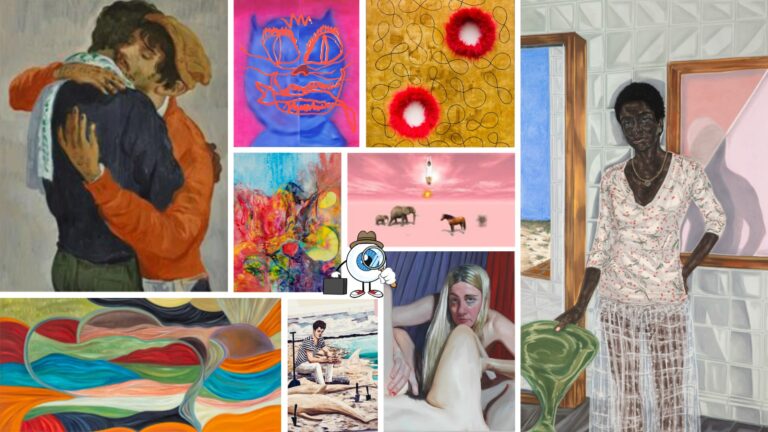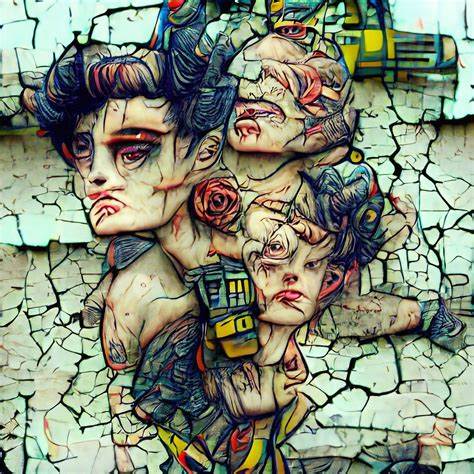In this article I'm going to present art trends, because I've been curious about the impact of innovations, especially technological ones, on the art world and this has led me to research the most innovative things happening in this universe.
In view of everything I've seen and will share with you here, I've noticed that the main trends involve technological innovations and crossovers between art and other disciplines.
Below I present the main innovative techniques and approaches that are really current in the art world and beyond then I'll show you what I found in my study specifically on the innovations of contemporary painting - considering techniques, materials, approaches and discourses that are really renewing pictorial language in 2025.
Art trends
1. Bioart with Integrated Artificial Intelligence
Artists are using living cells, fluorescent bacteria, fungi and genetically modified organisms to create works that grow, react and evolve - now with embedded AI to modify development parameters in real time. E.g. works that change color or shape based on environmental data (temperature, sound, CO₂).
Highlight: Anicka Yi and the use of biotechnology with AI in immersive sensory environments.
2. Mixed Reality (MR) with real-time data
In addition to AR (augmented reality) and VR (virtual reality), artists are creating mixed reality installations where the viewer interacts with physical and digital elements simultaneously. By 2025, the use of real-time urban or body data (heartbeat, emotions, traffic, weather) is revolutionizing this field.
Example: In Miebach's sculptures, for example, she uses weather data from
various environments and stories. She then presents this data in the form of music or sculptures
colored fabrics.
3. Generative creation with Multimodal AI (GPT-4o and similar)
Artists are using models like the GPT-4o to co-create paintings, musical compositions, visual poetry and installations. But not just as tools: AI is treated as a conceptual collaborator, helping to raise ethical, philosophical and aesthetic questions.
Strong trend: works that question authorship, memory and identity when created with AI.
4. Painting and sculpture techniques with living or changing materials
- Photosensitive pigments that react to light;
- Paints that change color with heat (thermochromic);
- Biomimetic surfaces that mimic structures in nature.
Some artists apply these paints with robots that paint live in interaction with the public.
5. Evolutionary NFTs and programmable on-chain art
The speculative NFT bubble has passed, but now there's a new wave: dynamic NFTs that change over time or with public action. This actively links the collector to the work. Works are also appearing on the blockchain as an artistic medium, not just as a certificate.
6. Programmable olfactory and synesthetic art
New devices are making it possible to create environments with scents synchronized to images, sounds and data, promoting complete sensory experiences.
Artists work with programmed sensory synesthesia, creating galleries that activate senses together.
7. Artworks that read emotions through AI
With cameras and biometric sensors, some installations analyze micro-expressions, speech rhythm, skin temperature and adapt the experience of the work to the emotion detected. The public never sees the same work twice.
8. Public facilities with regenerative technologies
Architect-artists are creating living sculptures that clean the air, capture noise pollution or produce energy. Urban art is also beginning to act as living infrastructure.
Example: artistic photovoltaic panels that react to light like petals and become kinetic art.
The silent revolution in contemporary painting
Now that you're up to date with the most innovative things going on in the art world, let's talk in particular about innovations in contemporary painting. What we will see here is not about digital art or installations, but about how traditional painting on canvas has been reinvented with new meanings, surfaces and intentions.
1. Painting with unconventional materials
The innovation here lies in the raw material of the painting, which is no longer just oil or acrylic paint. Contemporary artists are using it:
- Biological or living pigments (such as microorganisms that evolve on the screen);
- Paint made from atmospheric pollution (e.g. exhaust soot or metallic residues);
- Compounds that are sensitive to touch, heat or light, causing the painting to react to the environment or the viewer;
- Mixtures with soil, cement, resin, fabric, sand, synthetic skin, beeswax, animal blood (in criticism of cultural sacrifice).
Highlight: techniques that propose living or mutable works, which change with time or the weather, questioning the idea of permanence.
2. Expanded painting
It's about breaking down the traditional canvas as a boundary. Painting invades:
- Three-dimensional objects (such as painted sculptures);
- Walls, floors, furniture (composing a "pictorial environment");
- Layers of glass or acrylic superimposed (creating depths and physical overlaps).
Example: artists who build pictorial installations where the viewer physically enters the painting.
3. Painting-action and process as work
The focus is not just on the end result, but on the act of painting as a performance or living process, often documented on video or integrated into the exhibition space:
- Paintings created live in galleries with sensors or robots;
- Interactions with the public (e.g. the public interferes with the work with paint or gestures);
- Works that absorb movement, noise or environmental data during their creation.
Reference: artists like Tarek Atoui (although more connected to sound), influence this procedural dimension in painting as well.
4. Hybrid approaches: painting + artificial intelligence
This is one of the most pulsating frontiers:
- The AI generates preliminary compositions that the artist paints manually;
- The artist paints over works generated by AI, creating tension between human and machine;
- Algorithms determine patterns, colors or repetitions, which the artist interprets with a free brushstroke.
For example: Mario Klingemann or Sofia Crespo influence pictorially with algorithms as a plastic starting point.
Describing himself as a skeptic, Mario Klingemann seeks to question and subvert traditional creative processes and aesthetic principles in his work. Memories of Passers-by I uses AI to do just that. The work, which is completely autonomous, uses a complex system of neural networks to generate an endless stream of portraits: strange and sinister representations of male and female faces created by a machine.
Each portrait is unique and is created in real time, as the machine interprets its own result. For the viewer, the experience is like watching an act of endless imagination unfold in the mind of a machine -
while the human theme of his visions adds an extra layer of poignancy.
5. Painting of institutional and affective criticism
One of the great contemporary innovations is thematic and discursive:
- Paintings that recall colonial, Afro-Brazilian, indigenous and LGBTQIA+ memories with a strong symbolic charge;
- Craft or popular techniques revalorized as resistance painting (e.g. embroidery mixed with painting);
- Painting as a political, intimate and spiritual act in times of climate, technological and social crisis.
A Brazilian example: Jota Mombaça, who mixes performance, painting and criticism of coloniality with bold visual language.

6. New surfaces for painting
Artists are painting in:
- Mirrors, metals, printed circuit boards;
- Canvases with cuts, folds or seams (the canvas itself becomes sculpture);
- Inflatable structures, everyday objects, clothes or fabrics that move.
7. Synesthetic painting
Although still in an experimental field, there are artists developing:
- Paintings with microdoses of embedded aromas;
- Works that have a sound or light response, activated by sensors when approached.
The layers of now:
What I was able to conclude is that innovation in contemporary painting is no longer just about formal technique. In very objective terms, it occurs when:
- The story defies convention;
- The screen loses its limit and expands into space;
- The critical or affective intention transforms the gesture into language;
- Technology is incorporated without taking away from the human presence.
I'll end with a provocative thought. All this brought me back to the Dadaist Movement, which is worth revisiting at this point to calm some critics about what art is... Dadaism reminds us that art doesn't need to have meaning, logic or perfection. Sometimes it just needs be a provocation, a shout or a debauched laugh at the conventions of the world.
I hope this article has been useful for keeping you up to date and very inspiring for artists, collectors and curators. Let us know in the comments what you think of all the new things that are invading the art world! ; )







